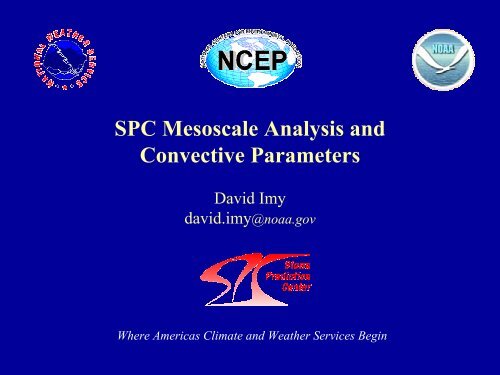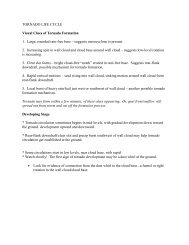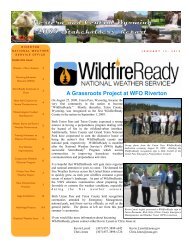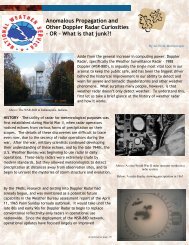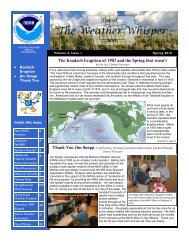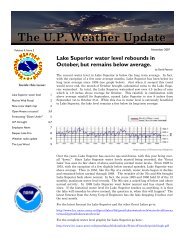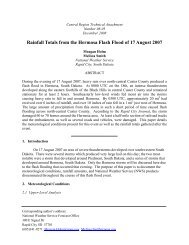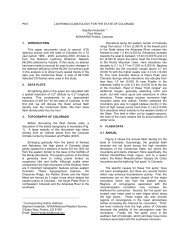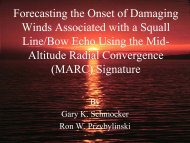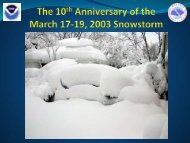SPC Mesoscale Analysis and Convective Parameters - NOAA
SPC Mesoscale Analysis and Convective Parameters - NOAA
SPC Mesoscale Analysis and Convective Parameters - NOAA
You also want an ePaper? Increase the reach of your titles
YUMPU automatically turns print PDFs into web optimized ePapers that Google loves.
<strong>SPC</strong> <strong>Mesoscale</strong> <strong>Analysis</strong> <strong>and</strong><br />
<strong>Convective</strong> <strong>Parameters</strong><br />
David Imy<br />
david.imy@noaa.gov<br />
Where Americas Climate <strong>and</strong> Weather Services Begin
Part I:<br />
<strong>SPC</strong> <strong>Mesoscale</strong> <strong>Analysis</strong><br />
A Key Part of the Diagnostic<br />
Process in the Prediction of<br />
Severe Thunderstorms
Why do Surface Mesoanalysis?<br />
• Forecast = diagnosis + trend<br />
• Incorrect diagnosis of atmosphere reduces the<br />
probability of making a correct forecast<br />
• Current operational models poorly predict specific<br />
atmospheric characteristics critical in convective<br />
forecasting, such as:<br />
- vertical thermodynamic structure<br />
- boundary layer conditions<br />
- sub synoptic low-level low level boundaries<br />
- affects of ongoing convection
Why do Surface Mesoanalysis? (cont.)<br />
• Mesoanalysis facilitates our ability to synthesize<br />
data from a variety of observational sources<br />
• Gain a better perspective of actual environmental<br />
conditions<br />
•Critical to track <strong>and</strong> identify mesoscale boundaries
Use Computer <strong>and</strong> Forecaster Analyses<br />
Together<br />
• Software quickly displays derived computer fields<br />
• Animation of fields provides unique visual information<br />
about trends<br />
•Let the computer do what it is best at doing =><br />
number crunching <strong>and</strong> visualization techniques<br />
•Let the human brain do what it is best at doing =><br />
synthesizing information from many sources <strong>and</strong><br />
applying conceptual models
Map <strong>Analysis</strong><br />
A Cornerstone of the <strong>SPC</strong><br />
Analyze temperatures, dew points, pressure <strong>and</strong> pressure<br />
changes on surface map<br />
Identify features such as gust front/outflow boundary, cold<br />
pool/mesohigh, mesolow, <strong>and</strong> wake depressions<br />
Also analyze 850 mb, 700 mb, 500 mb <strong>and</strong> 250 mb each raob<br />
run<br />
Temperatures (2C) <strong>and</strong> heights (60m) analyzed at 850 mb,<br />
700 mb <strong>and</strong> 500 mb.<br />
Also include dew points at 850mb, 12 hours height changes at<br />
500 mb <strong>and</strong> isotachs at 250 mb.
Observational Sources used in<br />
<strong>SPC</strong> Mesoanalysis<br />
• Surface observations, including mesonets<br />
• Satellite imagery<br />
• Radar<br />
• Animation of satellite <strong>and</strong> radar imagery<br />
• Lightning Detection Network
Boundaries of <strong>Convective</strong> Interest<br />
• Synoptic Scale Fronts (thermal boundaries)<br />
- cold front, warm front, quasi-stationary front<br />
• <strong>Mesoscale</strong> Fronts<br />
- sea/lake breeze fronts, convective outflow<br />
boundaries, differential heating boundaries owing to<br />
clouds, fog, vegetation, <strong>and</strong> terrain<br />
• Dry Lines (moisture boundaries)<br />
• Pressure Trough Lines<br />
• Convergence Zones
Techniques to Help Identify<br />
Surface Boundaries<br />
Basic Principles of Mesoanalysis (after Fujita, Miller, etc.)<br />
• Incorporate all available data to find sub-synoptic features<br />
• Be careful ignoring data that may appear “not to fit” with<br />
surrounding stations<br />
***This is very important***<br />
Continuity – What/where boundaries were located on previous<br />
analysis -- Best accomplished by hourly analyses!!!
Thermal <strong>and</strong> Moisture Gradients –<br />
Useful in locating Boundaries<br />
• Analyze isotherms (red) / isodrosotherms (green) at<br />
4-5F deg. intervals (warm season 2F deg. intervals)<br />
• Temperature analysis may be crucial at locating<br />
outflow boundaries (especially for weak<br />
wind/pressure fields)<br />
Thermal <strong>and</strong> moisture patterns help locate areas of<br />
convergence <strong>and</strong> severe storm potential
Mesoanalysis Pressure/Wind Data<br />
• Analyze pressure at 2 mb intervals (1 mb in<br />
summer).<br />
• Analyze 2 or 3-hourly pressure changes (1 mb)<br />
• Surface wind streamline analysis helpful in<br />
locating areas of convergence.<br />
• Wind shifts typically associated with boundaries<br />
• A wind speed decrease in unidirectional flow often<br />
associated with areas of convergence/divergence
Surface Pressure Changes<br />
1-2 hourly pressure changes help identify:<br />
-- mesolow /mesohigh couplets <strong>and</strong> boundaries<br />
** Concentrated fall/rise couplet enhance lowlevel<br />
convergence/shear by backing surface winds<br />
(enhancing tornado threat)<br />
-- clouds associated with surface pressure falls<br />
may be linked to a dynamical feature<br />
-- implications on thermal advection
Severe Weather Forecast<br />
Tools
<strong>Convective</strong> Available Potential<br />
Energy (CAPE)<br />
SBCAPE CAPE calculated using a Surface Based parcel<br />
MUCAPE CAPE calculated using the Most Unstable parcel<br />
in the lowest 300 mb<br />
MLCAPE CAPE calculated using a parcel consisting of<br />
Mean Layer values of temperature <strong>and</strong> moisture from the<br />
lowest 100 mb AGL
SBCAPE
MUCAPE
100 mb MLCAPE
Degree of Instability (MLCAPE)<br />
0-1000 J/kg weakly unstable<br />
1000-2500 J/kg moderately unstable<br />
2500-3500 J/kg very unstable<br />
3500+ J/kg extremely unstable
Research Proximity Soundings<br />
** Proximity soundings -- observed soundings considered to be<br />
“representative” of the storm environment<br />
** Proximity sounding parameters vary, but typically +/- 3<br />
hours <strong>and</strong> located within 100 nm of “storms”<br />
** Given the temporal/spatial resolution of radiosonde network,<br />
obtaining a large collection of proximity soundings is difficult.<br />
** Two results discussed: 1) Craven <strong>and</strong> Brooks ( 2001)<br />
2) Edwards <strong>and</strong> Thompson (Sep 2000)
Craven (<strong>SPC</strong>)-Brooks (NSSL) Research<br />
• Initially examined 0000 UTC soundings from 1996-1999<br />
(~60,000) <strong>and</strong> associated each sounding within 5 classes:<br />
•No Thunderstorms (45508 soundings)<br />
•Non-Severe Thunderstorms (11339 soundings)<br />
•Severe Thunderstorms (2644 soundings)<br />
•Significant Hail or Wind (512 soundings)<br />
•Significant Tornado (87 soundings)<br />
•CG lightning data <strong>and</strong> Storm Reports were used to<br />
determine the convective classes<br />
•Proximity defined as within 185 km of sounding <strong>and</strong> event<br />
occurring between 21-03 UTC (+/- 3 hours)
Edwards/Thompson (<strong>SPC</strong>)<br />
Research<br />
Used RUC2 proximity soundings for<br />
identified supercells<br />
Supercell sample included 96 tornadic<br />
<strong>and</strong> 92 non tornadic supercells
Craven/Brooks 0-6km Vector Shear<br />
0-6 km AGL Vector Shear<br />
Large overlap between thunder/severe,<br />
better discrimination between severe<br />
<strong>and</strong> sig. severe (especially sig.<br />
tornadoes)<br />
Seasonal Variation
Deep Layer Shear<br />
Deep layer shear = 0-6 km shear vector<br />
40+ kt suggests -- if storms develop -- supercells<br />
are likely<br />
30-40 kt -- supercells also possible if<br />
environment is very or extremely unstable<br />
About 15-20 kt shear needed for organized<br />
convection with mid level winds at least 25 kt
0-6 km Shear Vector
Craven/Brooks 0-1km Vector Shear<br />
0-1 km AGL Vector Shear<br />
Considerable overlap except for<br />
sig. tornadoes<br />
Seasonal Variation
Edwards/Thompson 0-1 km SRH
0-1 km SRH
Craven/Brooks MLLCL Heights<br />
Mean Layer LCL Height<br />
Again, isolates sig. Tornado from<br />
all other classes<br />
Seasonal Variation
Thompson/Edwards MLLCL Heights
MLLCL Heights
Craven/Brooks Findings<br />
• MLCAPE <strong>and</strong> 0-6 km shear did not discriminate<br />
between various classes of significant hail, wind, <strong>and</strong><br />
tornado events<br />
•Best discriminators between significant tornadoes (F2-<br />
F5) <strong>and</strong> all other classes were 0-1 km vector shear <strong>and</strong><br />
MLLCL heights
Thompson/Edwards Findings<br />
• Used RUC-2 analysis proximity soundings, but results<br />
consistent with Craven/Brooks findings<br />
•0-6 km shear is a good discriminator between supercells <strong>and</strong> nonsupercells<br />
•0-1 km SRH <strong>and</strong> MLLCL showed best discrimination between supercells<br />
producing significant tornadoes <strong>and</strong> other event classes<br />
• Application of parameter assessment depends on convective<br />
mode (discrete cells versus lines/multicell complexes).
SIMILAR SOUNDINGS - DIFFERENT CONVECTIVE EVENTS<br />
18 UTC BMX 16 Dec 2000 18 UTC BMX 16 Feb 2001
Two <strong>SPC</strong> Experimental<br />
Research Derived Products<br />
Supercell Composite Parameter (SCP)<br />
Significant Tornado Parameter (STP)
Supercell Composite Parameter (SCP)<br />
** Designed to identify areas for supercell<br />
development<br />
** Incorporates: MUCAPE (lowest 300 mb)<br />
0-3 km SRH, <strong>and</strong><br />
BRN denominator (1/2U**2)
SCP Equation<br />
Applied to over 500 proximity soundings (458 supercell,<br />
75 non supercell cases)<br />
SCP = (MUCAPE/1000 J/kg) x 0-3 km SRH/150<br />
m**2/s**2 x (0-6 km BRN shear term/40 m**2/s**2)<br />
If MUCAPE = 1000 J/kg; SRH = 150 M**2/S**2; BRN<br />
shear term = 40 m**2/s**2 , then SCP = 1<br />
> 1 for supercells;
Example of SCP Graphic
Significant Tornado Parameter (STP)<br />
<strong>Parameters</strong> include:<br />
1) 0-6 km AGL vector shear<br />
2) MLCAPE (lowest 100 mb)<br />
3) 0-1km SRH<br />
4) MLLCL Height<br />
5) MLCIN
STP Equation<br />
STP = (MLCAPE/1000 J/kg) x (0-6 km vector<br />
shear/20 m/s) x (0-1 km SRH/100 m**2/s**2) x<br />
(2000-MLLCL/1500 m) x (150 - MLCIN/125 J/kg)<br />
STP = 1 when, MLCAPE =1000 J/kg, 0-6km shear =20 m/s,<br />
0-1 km shear = 100 m**2/s**2, MLLCL = 500 m, <strong>and</strong><br />
MLCIN=25 J/kg
STP Considerations<br />
STP = (MLCAPE/1000 J/kg) x (0-6 km vector shear/20<br />
m/s) x (0-1 km SRH/100 m**2/s**2) x (2000-<br />
MLLCL/1500 m) x (150 - MLCIN/125 J/kg)<br />
** STP approaches zero as any shear or CAPE values nears zero<br />
** STP approaches zero as LCL height increases to 2000m<br />
** STP approaches zero as CIN increases to 150 J/kg<br />
MLCIN most useful prior to storm initiation
Example of STP
Mesoanalysis Summary<br />
•Use all available resources to aid in surface analysis<br />
(surface observations, mesonet data, satellite, radar,<br />
profilers, etc)<br />
•Continuity is extremely critical for mesoanalysis;<br />
should be done hourly, if possible<br />
•Mesoanalysis is an important part of the severe<br />
weather evaluation process
Research Summary<br />
•Proximity sounding research has aided <strong>SPC</strong> in better tools<br />
to identify areas for severe storm potential<br />
•Research has shown low MLLCL heights <strong>and</strong> strong 0-1 km<br />
SRH/shear vector are best predictors for stronger tornadoes<br />
(all other environmental conditions being equal)<br />
• 30-40+ kt 0-6 km shear is favorable for supercells<br />
•However, information misleading if initiation/ evolution of<br />
convective mode is not accurately forecast


